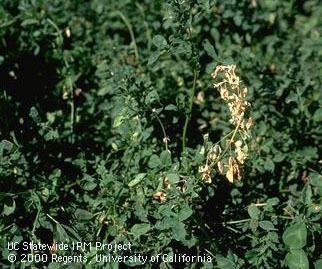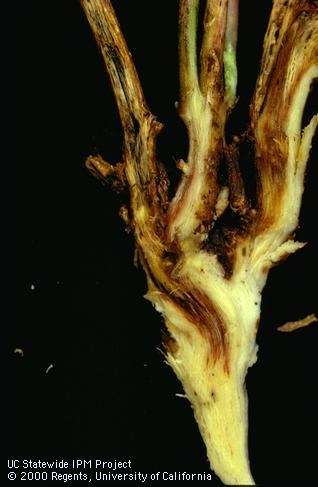
“Flagged” stems can be caused by several pathogens but when they appear in summer, are light tan in color and have the characteristic crook at the top, it is probably because the stem is infected with the fungus Colletotrichum trifolii (Figure 1). 
If the maximum damage caused by this fungus was a scattering of dead stems, then it would be of relatively little concern. However there is a much more damaging side to this disease: the fungus also attacks alfalfa crowns, eventually killing the plants. Infected portions of the crown are usually V-shaped, dry and bluish to black in color (Figure 3). As the infection moves deeper into the root, the discoloration turns tan to brick red. The crown rot phase of anthracnose can be a substantial contributor to stand decline and reduced yields.
Unlike many fungi-caused diseases of alfalfa that thrive in the cool temperatures of spring or fall, anthracnose thrives under warm, humid conditions - just what we have in the canopy of irrigated alfalfa during summer months.
The fungus survives winter in infected debris and in crowns of infected plants. When conditions become favorable in summer, spores are produced that can be moved with dew or irrigation water. As summer continues, the disease usually becomes more widespread. Infected plant parts carried on harvesting equipment can spread the disease to other fields. Ideally, younger alfalfa fields should be cut before older ones to reduce the spread of anthracnose and other diseases that tend to be more widespread in older fields compared to younger ones.
Crop rotations of 2 years or more should greatly reduce the disease pressure when alfalfa is planted again in a field. In addition there are varieties available with resistance to anthracnose (see the National Alfalfa Alliance publication “Winter Survival, Fall Dormancy and Pest Resistance Ratings for Alfalfa Varieties” at http://www.alfalfa.org/). If this disease has been a problem in previous years or is noticeable in current stands, select highly resistant varieties for future plantings.